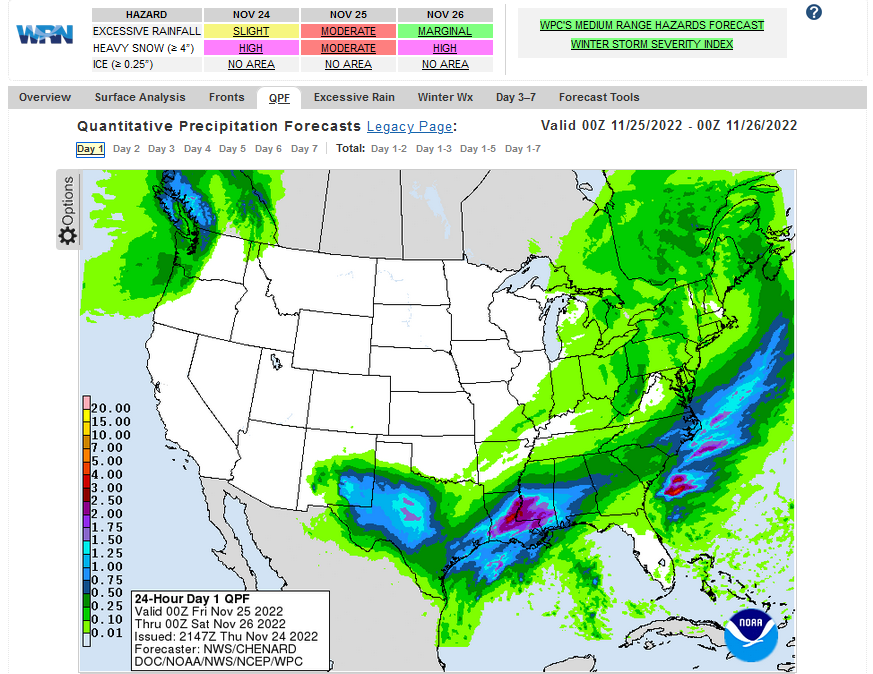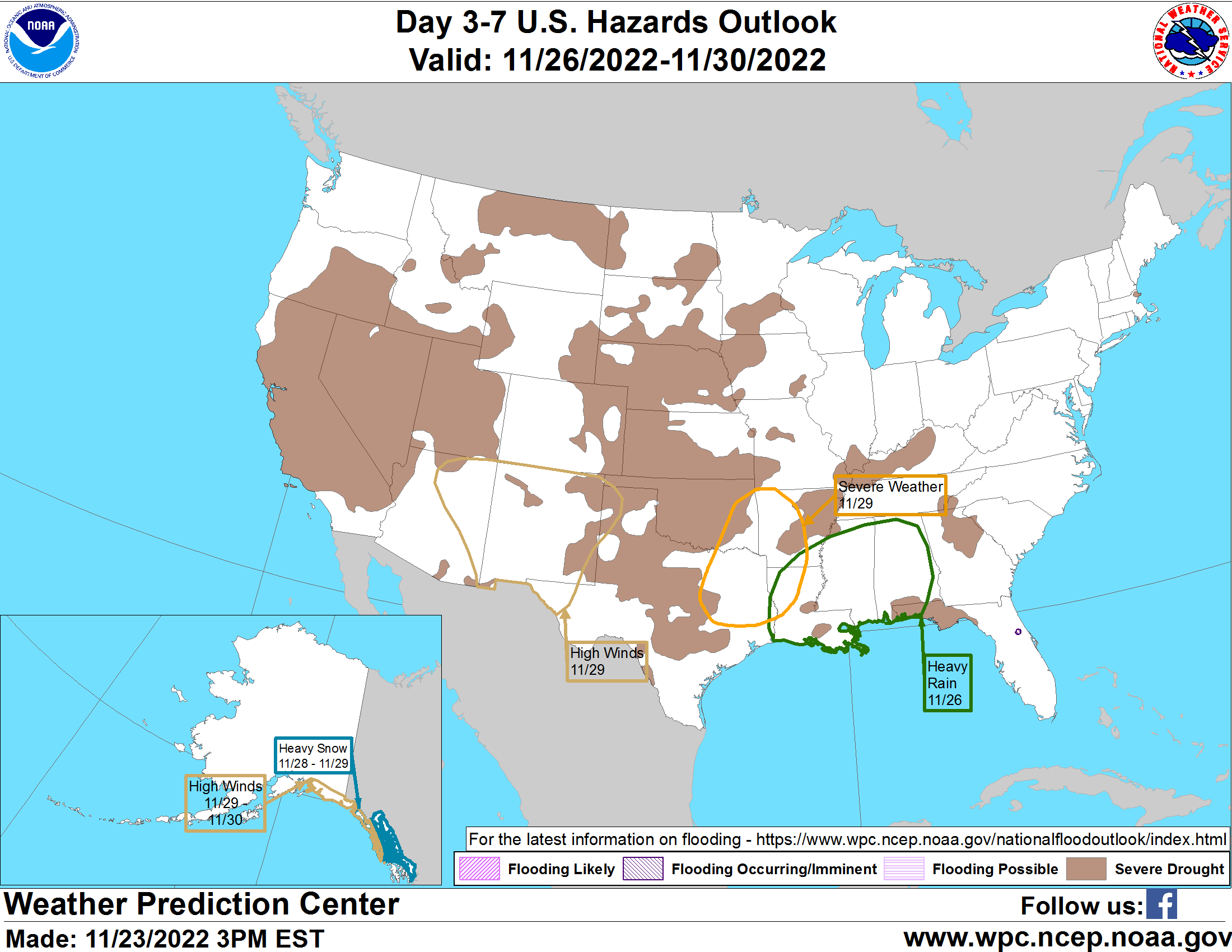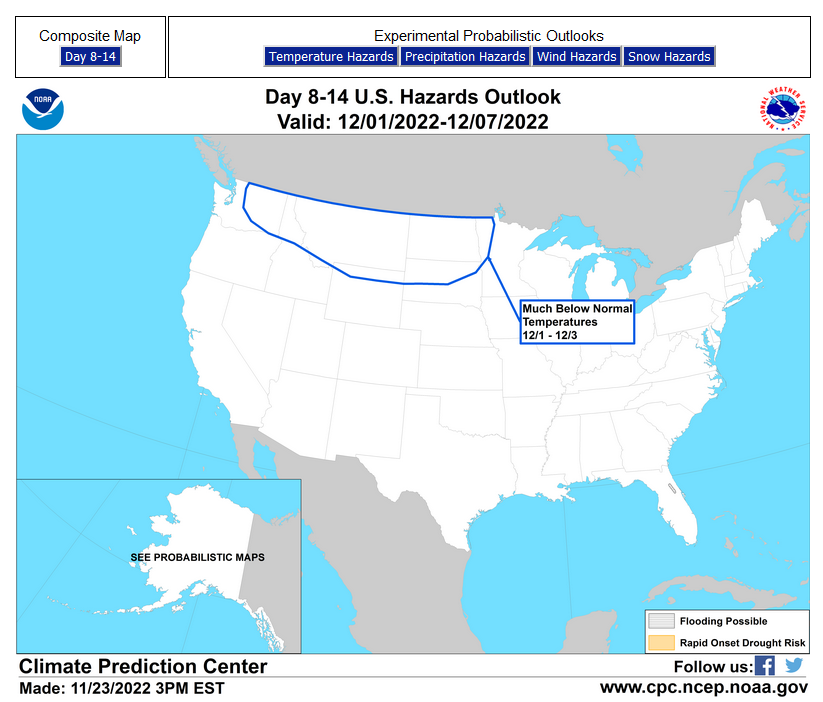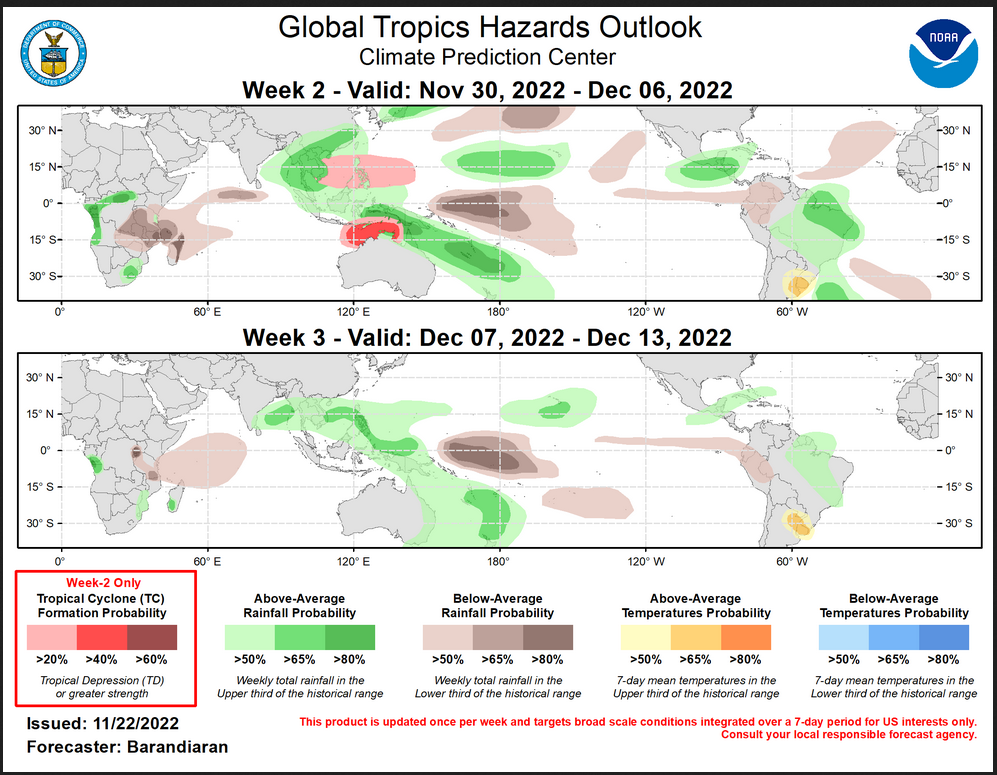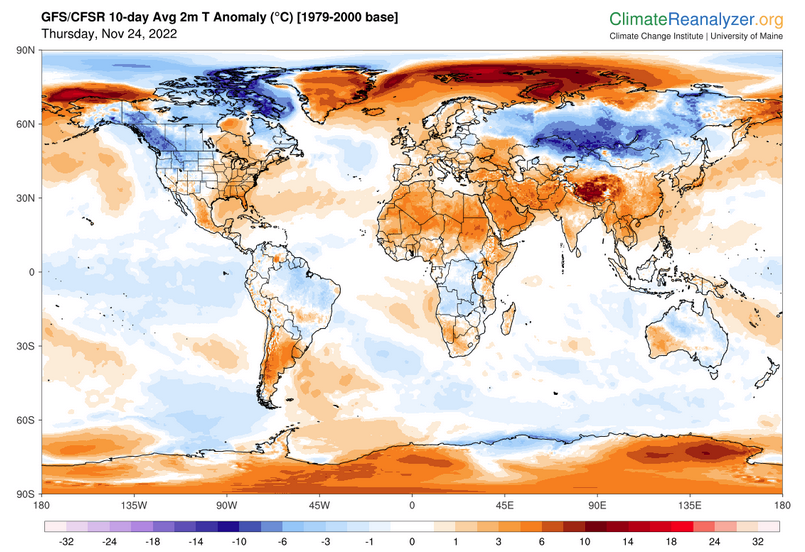Updated at 5:21 p.m. EST Friday November 25, 2022 (Our 28 Day Outlook will be posted soon)
...Heavy snow in parts of southeastern New Mexico and West Texas through tonight... ...Heavy rainfall and flash flooding will continue along the Texas Gulf Coast through tonight... ...Heavy mountain snow possible in the Pacific Northwest and northern Rocky mountains this weekend...
Continuation of the NWS Short Range Forecast (It is updated by NWS twice a day and these updates can be found here. We post at least one of those updates daily, sometimes both.
A deep upper level low over the southern High Plains will continue to produce wintry precipitation in the area through tonight, then the upper low will swiftly track northeast late Saturday into Sunday. Heavy snow with snow rates of 1-2 inches per hour is likely for parts of southeastern New Mexico and West Texas, and Winter Storm Warnings and Winter Weather Advisories are in effect. Additional snowfall accumulations near or above 4 inches will be possible, especially in higher terrain. Cold air accompanying this system will keep high temperatures 10-20 degrees below normal in the region through Saturday. Ahead of the upper low, a surface low is approaching the northern Gulf Coast from the south, bringing a frontal boundary north towards the area. Heavy rainfall will continue through tonight into Saturday morning, especially along the Texas Gulf Coast where 2-3 inches of rain are expected with locally higher amounts possible. There is a Moderate Risk of Excessive Rainfall (level 3/4) in effect for this area. Rain will be falling on saturated soils, which will increase the risk of flash flooding. Scattered to numerous instances of flash flooding are expected, and isolated significant flash flooding will be possible in the Moderate Risk area. As the upper level low moves northeast this weekend, the surface frontal system affecting the Gulf Coast will shift northeast as well. Precipitation associated with the system will move northeast through the weekend, spreading across the Mid-Atlantic and Great Lakes regions and into the Northeast by Sunday. Precipitation will fall as rain for most, but mixed wintry precipitation will be possible in northern New England and parts of the Great Lakes region. Monday, the system is forecast to push off the east coast, and mostly dry conditions will return to the east. In the West, two frontal systems are expected to move southeast across the region this weekend. The first cold front entered the Pacific northwest this afternoon and will push into the Southwest on Saturday. The second cold front will approach the Pacific Northwest Saturday night and push into the area on Sunday. Precipitation chances will increase following the passage of each front, but will be more widespread behind the second front, which will be associated with stronger upper level support. Precipitation is forecast to fall as rain at low elevations and as mixed precipitation and snow at mid and high elevations. Heavy snow will be possible Saturday and Sunday in the higher elevations of the Cascades and northern Rockies, and Winter Storm Watches and Winter Weather Advisories are in effect for areas where the highest impacts are expected.
Current forecast of heavy precipitation (Updates can be found HERE)
Maps that relate the forecast to geography can be found by clicking Here for Day 1 and Here for Day 2.
Today
Tomorrow
Here is a 60-hour animated forecast map that shows how the short-term forecast is expected to play out
 If it needs to be updated click here.
If it needs to be updated click here.
ATMOSPHERIC RIVERS
Click HERE to update. Here is some useful information about Atmospheric Rivers.
HAZARDS OUTLOOKS
Click here for the latest complete Day 3 -7 Hazards forecast which updates only on weekdays. Once a week probably Monday or Tuesday I will update the images. I provided the link for readers to get daily updates on weekdays. Use your own judgment to decide if you need to update these images.
Worldwide Tropical Forecast
(This graphic updates on Tuesdays) If it has not been updated, you can get the update by clicking here This is a new approach and covers weeks 2 and 3 not weeks 1 and 2. It has more information but I am having trouble getting used to it. As usual, it comes with a discussion which is below
Detailed Maps and Reports for the Western Atlantic and the Pacific Oceans
Below are four maps that summarize the situation for the Atlantic, Eastern, Central Pacific, and Western Pacific. Additional information can be accessed by clicking HERE
First the Atlantic
Click to view the forecast map and have access to additional information https://www.nhc .noaa.gov/gtwo.php?basin= atlc&fdays=5
Then Eastern Pacific
Click to view the forecast map and have access to additional information https://www.nhc.noaa.gov/gtwo.php?basin=epac&fdays=5
Then Central Pacific
Click to view the forecast map and have access to additional information https://www.nhc.noaa.gov/gtwo.php?basin=cpac&fdays=5
And the Western Pacific
Click to view the forecast map and have access to additional information https://www.metoc.navy.mil/jtwc/jtwc.html
Some Intermediate-Term Outlooks
Links to “Outlook” maps and discussions for three time periods. Days 6 – 10, Days 8 – 14, and Weeks 3 and 4. An outlook differs from a forecast based on how NOAA uses these terms in that an “outlook” presents information from deviation from normal and the likelihood of these deviations.
You have to click on the links because they do not update automatically and I do not want to have stale images in the article. But it is not difficult to click on a link and you get a large image plus a discussion. On Fridays in a separate article, we will show the images and provide a link in this article that article. But remember what you will see is the images as of Friday. But here you can get the current images simply by clicking on them. Then hit the return arrow at the upper left of your screen to return to the article. You will not find this information easily anywhere else.
| There was a drastic change in the forecast from Friday to Monday so you may want to click on the above links to see the current outlook. We show the maps in the weekend edition of our weather reporting. It is not possible at this time for us to provide all of the weather maps every day but we provide the links so readers can click on the links and view them. |
Worldwide Weather (The U.S. is part of the World so the U.S. forecast is included in these maps)
Below maps are the short-term forecast for precipitation and 10-day forecast for temperature and precipitation. I update them daily but if you are looking at an out-of-date version of this article the current forecast maps can be obtained HERE.
Month to Date Information
Month to date Temperature can be found at https://hprcc.unl.edu/products/maps/acis/MonthTDeptUS.png
Month to date Precipitation can be found at https://hprcc.unl.edu/products/maps/acis/MonthPNormUS.png

